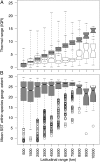Out of the tropics, but how? Fossils, bridge species, and thermal ranges in the dynamics of the marine latitudinal diversity gradient
- PMID: 23759748
- PMCID: PMC3696828
- DOI: 10.1073/pnas.1308997110
Out of the tropics, but how? Fossils, bridge species, and thermal ranges in the dynamics of the marine latitudinal diversity gradient
Abstract
Latitudinal diversity gradients are underlain by complex combinations of origination, extinction, and shifts in geographic distribution and therefore are best analyzed by integrating paleontological and neontological data. The fossil record of marine bivalves shows, in three successive late Cenozoic time slices, that most clades (operationally here, genera) tend to originate in the tropics and then expand out of the tropics (OTT) to higher latitudes while retaining their tropical presence. This OTT pattern is robust both to assumptions on the preservation potential of taxa and to taxonomic revisions of extant and fossil species. Range expansion of clades may occur via "bridge species," which violate climate-niche conservatism to bridge the tropical-temperate boundary in most OTT genera. Substantial time lags (∼5 Myr) between the origins of tropical clades and their entry into the temperate zone suggest that OTT events are rare on a per-clade basis. Clades with higher diversification rates within the tropics are the most likely to expand OTT and the most likely to produce multiple bridge species, suggesting that high speciation rates promote the OTT dynamic. Although expansion of thermal tolerances is key to the OTT dynamic, most latitudinally widespread species instead achieve their broad ranges by tracking widespread, spatially-uniform temperatures within the tropics (yielding, via the nonlinear relation between temperature and latitude, a pattern opposite to Rapoport's rule). This decoupling of range size and temperature tolerance may also explain the differing roles of species and clade ranges in buffering species from background and mass extinctions.
Keywords: biodiversity; biogeography; climate; macroecology; macroevolution.
Conflict of interest statement
The authors declare no conflict of interest.
Figures




References
-
- Hillebrand H. Strength, slope and variability of marine latitudinal gradients. Mar Ecol Prog Ser. 2004;273:251–267.
-
- Tittensor DP, et al. Global patterns and predictors of marine biodiversity across taxa. Nature. 2010;466(7310):1098–1101. - PubMed
-
- Hoeksema BW. Delineation of the Indo-Malayan centre of maximum marine biodiversity: The Coral Triangle. In: Renema W, editor. Biogeography, Time, and Place. Berlin: Springer; 2007. pp. 117–178.
-
- Crame JA. Evolution of taxonomic diversity gradients in the marine realm: Evidence from the composition of Recent bivalve faunas. Paleobiology. 2000;26(2):188–214.
-
- Jablonski D, Roy K, Valentine JW. Out of the tropics: Evolutionary dynamics of the latitudinal diversity gradient. Science. 2006;314(5796):102–106. - PubMed
Publication types
MeSH terms
LinkOut - more resources
Full Text Sources
Other Literature Sources
Molecular Biology Databases

